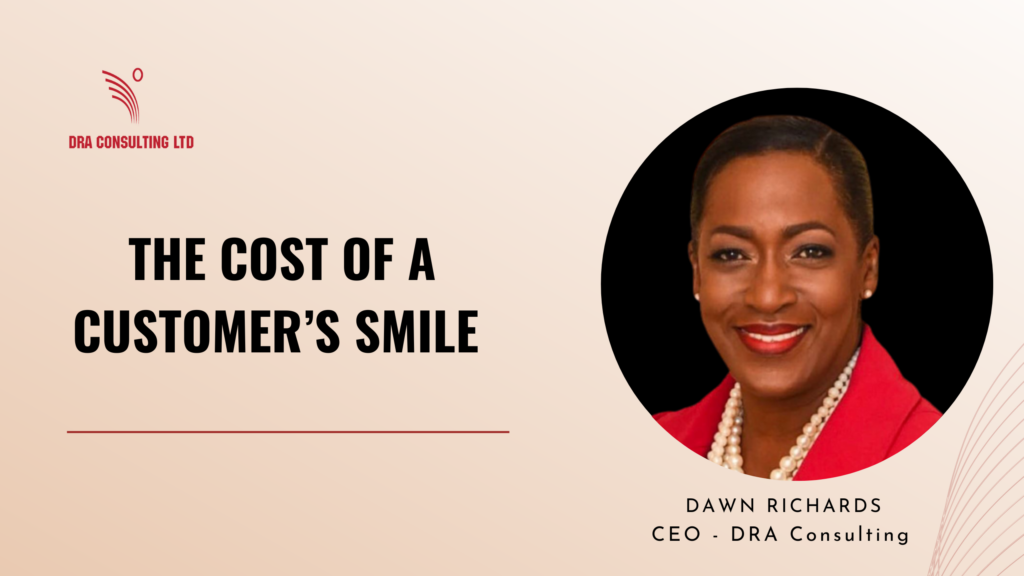Let me start by asking three questions. Have you noticed that employees at some businesses behave as though they are doing customers a favour during interactions? Has the thought about the cost of such unwelcome service delivery to the business, ever crossed your mind? Moreover, have you ever wondered about what factors affect the cost of generating a customer’s smile?
When a business does a poor job of managing key factors that influence customer happiness, the cost of generating that happiness becomes excessive. Conversely, taking the time to manage these factors efficiently, reduces wastage in both effort and expenditure.
We know the benefits of customers’ smiles, let’s take a look at some of the factors that a business has to get right, to control the cost of these smiles.
Have you noticed that employees at some businesses behave as though they are doing customers a favour during interactions? Has the thought about the cost of such unwelcome service delivery to the business, ever crossed your mind?
The overall disposition of a business to its customers matters. When a business has a “nothing is too much trouble for our customers” orientation, it develops a customer-centric compass, where no stone is left unturned, in seeking to serve customers and resolve their needs, exhaustively. Many businesses, when posed with the question, “What is your overall disposition to your customers?” are unable to give a clear answer.
If a business is not crystal clear on this fundamental question, chances are that customers are having a hit and miss experience.
Human factors contribute tremendously, to the cost of a smile. Insufficiency in talent capital, means transactions and interactions will be tainted by inefficiency, with the probability of transaction failures due to human error, going up proportionally to talent gaps.
Additionally, when humans interact, collisions occur. If collegiality is not nurtured through teamworking interventions that resolve the most deeply-rooted, interpersonal afflictions, the outcome of this internal scenario will be a series of parallel mishaps during customer interactions. What is unresolved on the inside, will collateralize itself into damage on the outside.
Another human factor is creative capital. Insufficiency in this area will create an ingenuity deficit, in resolving problems and needs. Many processes and procedures have a shelf-life expiry stamp. They would have been created to resolve issues and needs that now require new approaches (from an ingenuity surplus), to be generated by freshly-minted, creative minds.
Moreover, have you ever wondered about what factors affect the cost of generating a customer’s smile?
Business intelligence and technology density are big contributors to cost. Some businesses have been early adopters of evolving technologies, as seen in the integration of artificial intelligence and digital engineering into their operations.
Digital labour at some point, will become as ubiquitous as human labour in many businesses. Martech stacking tools, customer experience surveillance tools, social media strategy tools, point of sale and enterprise resource planning systems, are all part of the world of evolving technologies.
We know that technology adoption can be disruptive to the status quo of a business, but when useful digital transformation is undertaken, with targeted optimization and clear benefit indicators, the gains can keep a business squarely in the game. The trick is to introduce technology in a strategic way into a business, so that the benefits of technology expansion, outweigh the high cost of underutilization.
Leadership capital is needed to grow, scale and prosper a business. It is possibly one of the most critical factors that can cost a business its life and its longevity. When infused with the right leadership a business can sustain its relevance with evolving customers and profitability through the constancy of market upheavals.
When a business does a poor job of managing key factors that influence customer happiness, the cost of generating that happiness becomes excessive. Conversely, taking the time to manage these factors efficiently, reduces wastage in both effort and expenditure.
As a service transformation practitioner, I have a front-row seat that allows me to observe senior leaders and executives in action. I see leaders who nail the conversion of vision to strategy, to action, to results, but at times, show a marked insufficiency in the area of self-evolution.
Self-evolution allows individuals to overcome the typical pitfalls of life and in the case of business leaders, the pitfalls that come with elevated status and high office.
In this insufficiency space, I see some leaders who allow themselves to become aloof, arrogant and anti-social. They become unchallengeable. The danger with this latter quality, is that it breeds the creation of a personal orbit that comprises silent individuals and a business orbit of silent employee communities. No one dares to challenge these leaders.
You can well imagine the price that this “universe of one” exacts on the business. Moreso, the cost of exclusion of the rich points of reference that ordinarily, would be contributed by a diverse community.
The leaders who escape this fate, are those who are not entrapped by legacy thinking (they embrace cognitive flexibility).
In doing so, these are the leaders who ensure that ignorance does not contribute to the cost of the customer’s smile.

